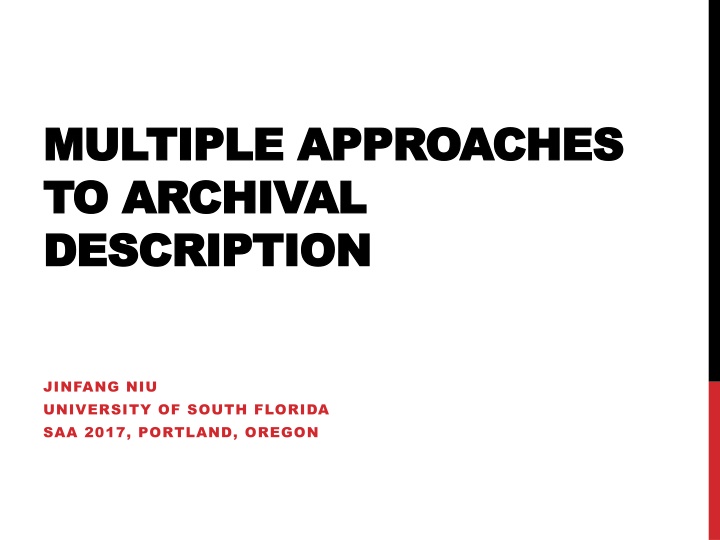
Innovative Approaches to Archival Description and Metadata Encoding
Explore multiple approaches to archival description, including EAD 3 for online conversion, the future of EAD, alternative encoding methods like METS and OAI-ORE, the benefits of linked data, and the use of separate linked metadata records for enhanced discoverability. Learn about the evolving landscape of archival standards and technologies.
Download Presentation

Please find below an Image/Link to download the presentation.
The content on the website is provided AS IS for your information and personal use only. It may not be sold, licensed, or shared on other websites without obtaining consent from the author. If you encounter any issues during the download, it is possible that the publisher has removed the file from their server.
You are allowed to download the files provided on this website for personal or commercial use, subject to the condition that they are used lawfully. All files are the property of their respective owners.
The content on the website is provided AS IS for your information and personal use only. It may not be sold, licensed, or shared on other websites without obtaining consent from the author.
E N D
Presentation Transcript
MULTIPLE APPROACHES MULTIPLE APPROACHES TO ARCHIVAL TO ARCHIVAL DESCRIPTION DESCRIPTION JINFANG NIU UNIVERSITY OF SOUTH FLORIDA SAA 2017, PORTLAND, OREGON
EAD 3 Great for converting analog finding aids into online format Today, no longer in the conversion stage, need to adapt archival description to current technologies Changes in EAD 3 is not significant enough Creating new elements Deprecate existing elements Replace some elements Support for multilingual description, etc. The EAD Technical subcommittee acknowledges this The transition from mixed presentation and data to full data is not complete. One big reason is the resistance from the existing users of EAD: dramatic change causes information loss during migration.
FUTURE OF EAD Some countries do not use EAD. Even NARA does not use EAD. Without significant changes, sooner or later it will stop being used To stay relevant, it needs to be completely remodeled The conceptual model created by the ICA Expert Group on Archival Description could be a foundation. It identifies the core descriptive entities, properties of these entities, and relations among them. Utilize linked data technology
OTHER ENCODING METHODS METS and OAI-ORE Represent hierarchical structure Use external metadata vocabularies to describe the resources DC, FOAF, etc. Generic, can be used for any kinds of digital resources Widely used ArchivesSpace and Dspace exports structure and metadata of archival collections in METS format. Both Europeana and DPLA are based on OAI-ORE Facilitate integrated access to LAM resources
OAI-ORE is a linked data-based standard Linked data makes archival descriptions more granular An archival description becomes a RDF graph, and each node and edge within this graph is individually discoverable. In addition to supporting the discovery of records, linked data based on archival description potentially can support the search for information about any entities within archival descriptions and provide direct answers to queries. EAD based finding aids only support the search for the top unit of description
SEPARATE AND LINKED METADATA RECORDS Many national archive use this approach, usually based on relational databases Each component has its own metadata record Metadata records for components are linked to form a hierarchy Each component is individually discoverable More granular than the traditional finding aid, and makes each component in a record aggregate individually discoverable.
WEBSITE STYLE FINDING AIDS Provide more advanced features than what EAD can offer navigation structures, drop-down menus, advanced search functionalities, slideshows, animations, audio, and video, automatically turn pages for multipage documents, track download statistics, etc. Use general terms instead of technical archival terms so that they are easier to understand for novice users. Example finding aid for the John Peabody Harrington Collection maintained by the National Anthropological Archives (http://anthropology.si.edu/naa/harrington/). About the Collection in place of Scope and Content About J. P. Harrington in place of Biography or history . Similar to a general guide rather than a specialized finding aid, user friendly Not sure about its portability






















